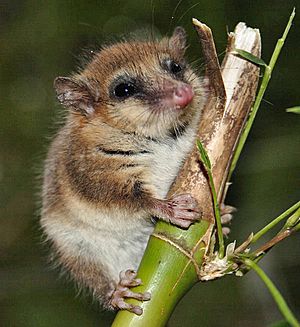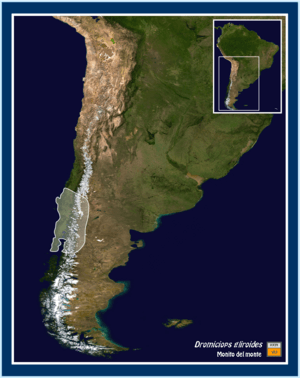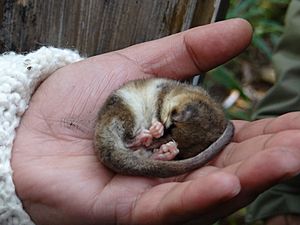Monito del monte facts for kids
Quick facts for kids Monito del monte |
|
|---|---|
 |
|
| Conservation status | |
| Scientific classification | |
| Genus: |
Dromiciops
|
| Species: |
gliroides
|
| Subspecies | |
|
|
 |
|
| Range of the monito del monte | |
| Synonyms | |
|
Didelphys australis Goldfuss, 1812 |
|
The monito del monte (which means "little monkey of the mount" in Spanish) is also known as the colocolo opossum. Its scientific name is Dromiciops gliroides. People in the Mapudungun language call it chumaihuén. This tiny marsupial lives only in southwestern South America, in Argentina and Chile.
It is the only living member of a very old group of animals called Microbiotheria. It is also the only marsupial from the superorder Australidelphia found in the New World. All other marsupials in the Americas belong to a different group. The monito del monte is active at night (this is called nocturnal). It lives in trees (this is called arboreal life). It uses its partially prehensile tail to help it climb. It lives in thick forests of South American mountain bamboo in the Valdivian temperate rain forests of the southern Andes mountains. This animal mainly eats insects and other small creatures. It also enjoys eating fruit.
Contents
About the Monito del Monte
The monito del monte, Dromiciops gliroides, is the only living animal in its special group called Microbiotheria. A British zoologist named Oldfield Thomas first described it in 1894.
The name Dromiciops comes from how much the monito del monte looks like the eastern pygmy possum. The word gliroides means "similar to a dormouse" in Latin and Greek. A dormouse is a type of rodent.
In 1943, an American zoologist named Wilfred Hudson Osgood found two types (subspecies) of the monito del monte:
- Dromiciops gliroides australis: This type lives in the Valdivian temperate rain forest in south-central Chile.
- Dromiciops gliroides gliroides: This type lives in the northeastern part of Chiloé Island.
Where it Lives
Monitos del monte live in the thick forests of the highlands in Argentina and Chile. They mostly stay in trees. They build round nests using strong, water-resistant leaves from the colihue plant. They line these nests with moss or grass. They place their nests in safe spots in trees, like inside tree holes or under fallen logs. Sometimes, they cover their nests with gray moss to help them blend in (this is called camouflage). These nests keep the monito del monte warm, both when it is awake and when it hibernates.
What it Looks Like
Monitos del monte are small marsupials that look a bit like mice. They have a special set of teeth, just like opossums. They have a total of 50 teeth. Their weight can be from 16–42 g (0.56–1.48 oz). They have short, thick fur that is mostly brown-gray. They have white patches on their shoulders and back. Their belly is a creamy or light gray color. Monitos del monte have clear black rings around their eyes. Their small, furry ears are round, and their snout is short.
Their body length (from head to body) is about 8–13 cm (3.1–5.1 in). Their tail is between 9 and 13 cm (3.5 and 5.1 in) long. Their tails can grasp things a little bit (this is called prehensile). Most of their tail is covered in fur, except for about 25–30 mm (0.98–1.18 in) of the underside. This bare part of their tail might help them grip trees better. The base of their tails also stores fat. They use this fat during winter hibernation. In just one week, a monito del monte can store enough fat to double its body size!
Differences Between Males and Females
At the end of summer, female monitos del monte are usually bigger and heavier than males. Their tails are also thicker because that is where they store fat. This difference suggests that females need more energy than males for hibernation. This size difference only happens at this time of year, not all year round.
Reproduction and Life Cycle
Monitos del monte usually have one partner for life (this is called a monogamous mating system). Female monitos del monte have a well-formed, fur-lined pouch with four teats inside. They usually have babies once a year in the spring. They can have between one and five babies at a time. However, they can only feed a maximum of four babies. So, if there are five young, one might not survive.
When the young are old enough to leave the pouch (around five months old), they are cared for in a special nest. After that, the mother carries them on her back. The young stay with their mother even after they stop drinking milk. Both males and females are ready to have their own babies when they are two years old.
Habits
The monito del monte is good at living in trees (this is called arboreal life). Its tail and paws can grasp things (this is called prehensile). It is mostly active at night (this is called nocturnal). Depending on the temperature and how much food is available, it spends much of the day in a state of torpor. Torpor is like a deep sleep where the animal slows down its body. This helps it save energy when the weather is bad or when there isn't much food. Instead of looking for food when there's none, it rests.
The animal covers its nest with moss. This helps hide the nest and keeps it warm and safe from bad weather.
Diet
Monitos del monte mainly eat insects. They find insects and other small creatures on tree branches and in cracks in the bark. But during the summer, they eat a lot of fruit, especially fruit from mistletoe plants.
Helping Plants Grow
A study in the forests of southern Argentina showed that monitos del monte help a plant called Tristerix corymbosus (a type of mistletoe) spread its seeds. The monito del monte is the only animal that spreads the seeds for this plant. Without it, the plant would likely disappear. The monito del monte eats the mistletoe fruit, and the seeds start to grow inside its gut. Scientists think that these two species have been helping each other for a very long time, possibly 60–70 million years.
Conservation
In recent years, the number of monitos del monte has gone down. Because of this, the species is now listed as 'near threatened'. Many things are causing their numbers to drop:
- Their home (habitat) is already small, and it is shrinking because of deforestation (cutting down trees).
- When domestic cats are introduced, the number of monitos del monte goes down.
- Some local people think this animal brings bad luck. Houses have even been burned down after a monito del monte was seen inside.
- Other people believe this marsupial is poisonous or causes diseases. But in reality, they do not harm humans.
The monito del monte is not the only living thing that will be affected if it becomes endangered. A specific type of tick, Ixodes neuquenensis, only lives on the monito del monte. So, this tick depends on the monito del monte to survive. Also, the T. corymbosus plant needs the monito del monte to spread its seeds and reproduce.
Not much is being done right now to protect them. However, scientists are doing studies on Chiloé Island that might help with future protection efforts. Monitos del monte have been found in the Los Ruiles National Reserve and the Valdivian Coastal Reserve, which are protected areas in Chile.
- Gardner, A.L. (2005). "Order Microbiotheria". In Wilson, D.E.; Reeder, D.M. Mammal Species of the World: A Taxonomic and Geographic Reference (3rd ed.). Johns Hopkins University Press. p. 21. ISBN 978-0-8018-8221-0. OCLC 62265494. http://www.departments.bucknell.edu/biology/resources/msw3/browse.asp?id=10600004.
Images for kids
See also
 In Spanish: Monito del monte para niños
In Spanish: Monito del monte para niños




